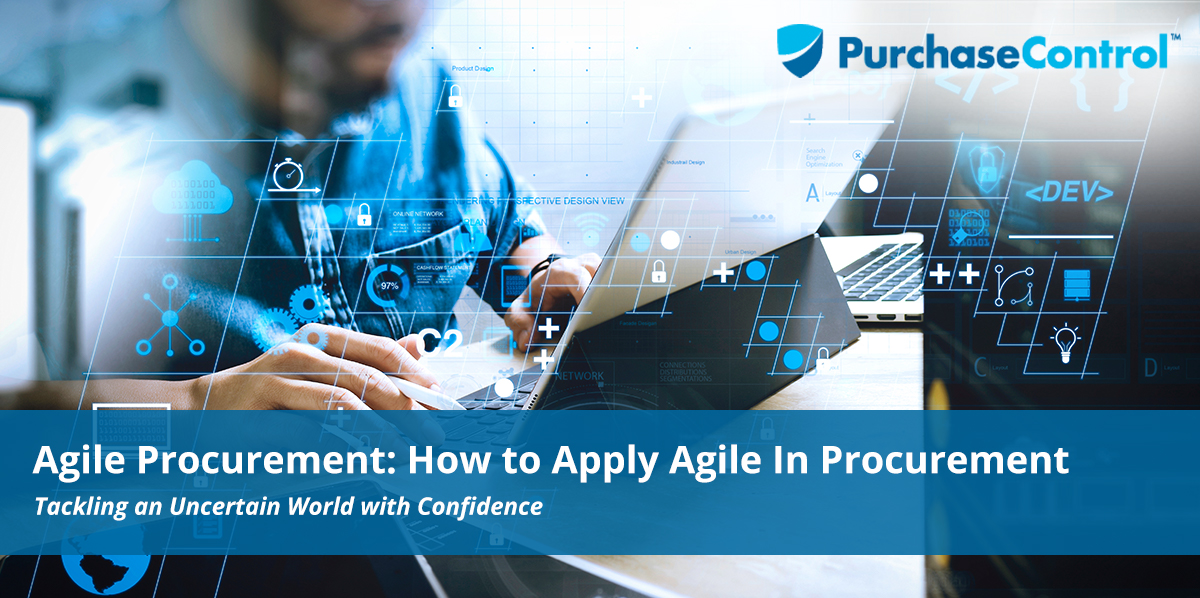If you’re part of a procurement organization, a project manager, or have a role in project management, you probably already know that effective procurement is about more than creating and executing plans. You need to be able to react as effectively as you act, especially in a complex global marketplace where uncertainty reigns and competitive advantage goes to those who can roll with the punches. That’s why many procurement professionals have begun to integrate the process improvements known as agile methodologies into their workflows.
It might sound like just another business bingo buzzword, but agile procurement is possible for those willing to embrace agile principles and use the techniques and tools needed to build a forward-thinking, collaborative procurement environment.
What is Agile Methodology?
Its origins lie in the realm of software development, but the set of principles and processes known as the agile methodology has, in recent years, become standard operating procedure for everyone from automotive innovators to content creation firms. It is markedly different from traditional procurement in a number of key ways, and guided by both the agile manifesto and twelve central tenets derived from it (often referred to as agile principles).
Determining exactly what agile means in a given context isn’t always easy. But the twelve agile principles are always at the core.
- Customer Satisfaction is King. Customer satisfaction is the highest priority, with an emphasis on early and continuous value delivery.
- Change is Opportunity. Change is welcome, regardless of when it occurs. Change brings with it opportunities to maximize customer competitive advantage and satisfaction.
- Speed and Value Go Hand-in-Hand. High-value deliverables reach the customer in the shortest time possible, with frequent updates.
- Collaboration Conquers Conflict. Project members from different business units should sit together by team, rather than department, and work together every day to ensure total transparency of communication and shared commitment to success.
- Power to the People. Projects are built around, and driven by, passionate stakeholders. Teams receive the tools, support, and working conditions they need to succeed, and are trusted to complete the tasks assigned.
- Emphasize the Interpersonal. Face-to-face communication is the most effective and efficient way for teams to share information.
- Demonstrable Value Drives Every Project. Deliverables that meet or exceed customer expectations for completeness, accuracy, and value are the most useful benchmarks.
- Keep Things Steady and Sustainable. While delivering value to customers is job one, processes should be developed, reviewed, and optimized for sustainability to ensure all stakeholders can maintain a steady pace for as long as the project requires.
- Continuous Improvement Ensures Agility. Processes should be as good as they can be when created and implemented—and become even more effective over time through continuous improvement.
- Keep It Simple. Maximum returns for minimal resources.
- Self-Guided Teams Succeed. Optimal results arise from agile project teams that are allowed to self-organize.
- There’s Always Room for Improvement. Continuous improvement doesn’t just apply to processes. Teams should regularly evaluate their efficacy and efficiency, and make the changes necessary to improve both as much as possible.
Guided by these principles, project teams in any industry can begin to shift their focus away from rigidity and toward agility. To be agile means to be comfortable with, and able to take advantage of, the only constant in the age of digital transformation: change.
Agile Procurement Terms
In discussing the agile approach, it’s important to have a working knowledge of the terminology used. The Agile Alliance maintains a comprehensive glossary to provide complete context, but for those seeking to understand and implement agile processes, a few of the most important terms to know include:
Agile Project Management: At their heart, agile processes are iterative, collaborative, and contextually reactive. They are data-driven, emphasize transparency, and focus on demonstrative value. They prioritize results and shared success, promoting healthier, more productive business relationships while simultaneously delivering value that simply wasn’t possible to achieve under old paradigms. Agile project management puts these principles into direct practice through the use of various tools.
Customer(s): The party or parties who commissioned the project and whose satisfaction with the project’s deliverables is of paramount import.
Sprint: A sprint is one iteration of a process.
Scrum: Perhaps the most well-known of the agile frameworks, Scrum is an iterative set of processes using sprints to achieve the goals of any given project. It is often conflated with or used interchangeably with “agile,” but Scrum is a distinct and specific application of general agile principles.
Scrum relies on three distinct roles—Product Owners, Scrum Masters, and Scrum Teams—as well as three main artefacts—Burndown Charts, Product Backlog, and Sprint Backlog—to complete projects, meet or exceed customer expectations, and deliver value.
- Product Owners are “the voice of the customer.” They interface with the project team and are responsible for conveying the overall project vision, essential decision making, and team leadership, among others. Depending on their scope, some projects may have two or more product owners responsible for varying roles.
- Scrum Masters track overall project status and conduct daily standup meetings. Their primary role is to remove obstacles to completion and minimize delays. That said, because agile methodology emphasizes self-assignment of tasks, scrum masters should be viewed more as shepherds and caretakers than overlords or taskmasters.
- Scrum Teams are contextual and ever-changing teams, staffed from various sources, dedicated to completing projects. Ideally, they follow the agile principles of collaboration and communication, guided by the Scrum Master and Product Owner(s) but ultimately relying on the 12 principles to assign and complete the tasks necessary to complete the project’s deliverables and maximize customer satisfaction.
With regard to the three artefacts used:
- Burndown Charts are motivational tools displaying the amount of work yet to be completed compared to the amount of time remaining.
- Product Backlogs are collections of user stories and tasks remaining for the project as a whole.
- Sprint Backlogs are collections of user stories and tasks remaining for the current sprint.
Daily Standup Meetings: Fifteen- to thirty-minute meetings in which the Scrum Master and Scrum Team precisely discuss the day’s tasks and priorities, with an emphasis on brevity.
Teams also meet to plan and review sprints. Retrospective meetings are used to identify opportunities for process refinements to achieve continuous improvement.
These activities are conducted once every sprint, except for the daily standup meeting, which is conducted once a day during the course of the current sprint.
Scrum discourages participants from attending any non-scrum meetings while they are completing a sprint.
Stakeholders: Folks outside the team with a vested interest in its deliverables and success.
Tasks: Specific goals and responsibilities refined from user stories, to be completed during sprints.
User Stories: In software development, this term refers to the narratives provided by customers to provide a general outline of their desires, expressed using the following format:
As a <end-user-type>, I want to be able to <user-requirement> so that <reason>.
This same format persists in general agile methodologies, with a given process or product replacing the desired feature. While user stories are designed to be independent from one another, the complexities of real-world project management mean cross-dependencies do occur. In these instances, Epic Stories are created, wherein interrelated independent stories are targeted as part of a larger project.
“At their heart, agile processes are iterative, collaborative, and contextually reactive. They are data-driven, emphasize transparency, and focus on demonstrative value. They prioritize results and shared success, promoting healthier, more productive business relationships while simultaneously delivering value that simply wasn’t possible to achieve under old paradigms.”
Transitioning to Agile Procurement
Applying the principles outlined in the agile methodology to procurement processes is easy when one considers the ways in which these principles compliment digital transformation and the ongoing evolution away from traditional procurement models. Unlike those models, which emphasized fixed, cost-reduction solutions, agile procurement seeks to recontextualize the procurement function as a foundation of value generation supporting organizational goals and meeting business needs.
Consider the ways in which agile procurement differs from its more rigid predecessors:
ASPECT | TRADITIONAL PROCUREMENT | AGILE PROCUREMENT |
| Deliverables | Fixed, with extensive planning and documentation. | Sprint-based, reactive, and iterative, with a focus on meeting expectations rather than fixed benchmarks or deliverables. |
| Commodities Acquisition | Handled by the project manager; may or may not provide spend transparency to all stakeholders. | Handled by the procurement team; Iterative and process-driven. |
| Contract Management | Confrontational and competitive. | Collaborative and communicative. Focused on strong supplier relationships and shared success. |
| Supply Chain Management | Project-locked. Vendors are difficult or impossible to replace once a project is funded and underway. | Iterative and contextually responsive; vendors can be readily changed after a given sprint as demanded by changing circumstances. |
These are but a few of the practical benefits that occur when you take an agile approach to procurement.
Recognizing the potential benefits is one thing; but how can you best apply the twelve principles to your own procurement?
The answer for many procurement professionals is to embrace another transformative procurement tool: advanced procurement software solutions, such as the ones offered by PurchaseControl.
With powerful and intuitive technological tools such as advanced data analytics, robotic process automation, and artificial intelligence (AI) that learns as it works, you can introduce agile processes as a core component of your business process management strategy.
In many ways, automated, AI-supported procurement is agile procurement.
- Iterative and continuous improvement for your entire Procure-to-Pay (P2P) process.
- Centralized, shared data collection, access, and management.
- Collaborative, mobile-friendly, and cooperative communication at all levels.
- Integration with project management, enterprise resource planning (ERP), accounting, and marketing software makes it easy to build diverse teams that work face-to-face and share resources without having to struggle against siloed data.
- Full data transparency and real-time data analytics make it easy to measure value creation, control spend, improve processes, and take an iterative approach to complex projects while maintaining overall visibility.
- Improved vendor communication and tools like vendor portals build stronger supplier relationships, connect your system with even more valuable performance and compliance data, and allow for strategic, collaborative thinking and decision making that prioritizes shared success for both you and your suppliers.
By choosing a procurement solution with these capabilities, you’re effectively choosing agile procurement as your preferred paradigm for growth, innovation, and competitive success.
Expect and Overcome the Unexpected with Agile Procurement
Achieving agility in your procurement organization begins with understanding the necessary and significant changes required to make it happen. By pivoting away from prescriptive procurement and toward the flexibility of agile procurement, your team will be able to generate real value for all your stakeholders. They’ll harness the potential, rather than fear the implications of, change, and help redefine procurement as a source of value and continuous improvement across your entire company.
Get Agile, Responsive, and Powerfully Productive Procurement with PurchaseControl.
Find Out How








